THE ASTRALUX PROJECTOR

| Left: Unknown item: 1951?
This picture comes from a book titled Curious Moments, pub Konneman 2006, in Germany. The cover says it is an 'archive of the century', and is a collection of photographs from STV-Bild/Das Photoarchiv. Googling for this organisation brings up STV- The Swiss Gymnastics Federation- which does not appear to be relevant.
What on earth is it? At the left it looks like some sort of telescope, with a lens at the end. However, if it is there seems no reason why the rest of the body to the right should be twice the diameter, and even larger at the rightmost end. In the middle there is an arrangement of four rollers that allows the instrument (?) to be moved back and forth a couple of feet in its tubular travelling-frame. At the right there is a big handwheel, of unknown purpose; such handwheels are not usually found on the side of telescopes.
At the top of the body to the right there are what appear to be four angled pipes for drainage, (??) which perhaps suggest chemical engineering.
|
|
The caption is as it appears in the book; it suggests 1951 as the date. Further mystery is added by the figure at lower left, wearing some sort of protective clothing. It looks rather like an early WW1 gas-mask, except they only covered the head and were not belted at the waist as shown here. There are no obvious arrangements for breathing, which could be a problem. Oddest of all, there appear to be two blunt antennae protruding just above the eye-pieces. If this is protective clothing, the wearer seems to have forgotten to cover his hands.

RESPONSES
Two correspondents have identified the gear worn by the man as protection for welders, with the 'antennae' above the eye-pieces a second set of dark lenses that can be swung down to deal with very strong lights. There is agreement that it is some sort of optical instrument, probably with a big arc lamp at the right end. That would explain the welding gear for eye protection, and why the hands are not covered.
At the right is some sort of sector-and-roller affair that looks as if it allows the tube to elevate; possibly controlled by the big handwheel. The hooded shape of the main tube suggests it's designed to keep weather off the smaller tube. But if it is an optical thing, why is the main tube so much bigger than the smaller tube with the lens?
My thoughts are hardening that it is some sort of special light-projector; something apart from an ordinary searchlight. Very possibly for projecting images on clouds.

THE ANSWER
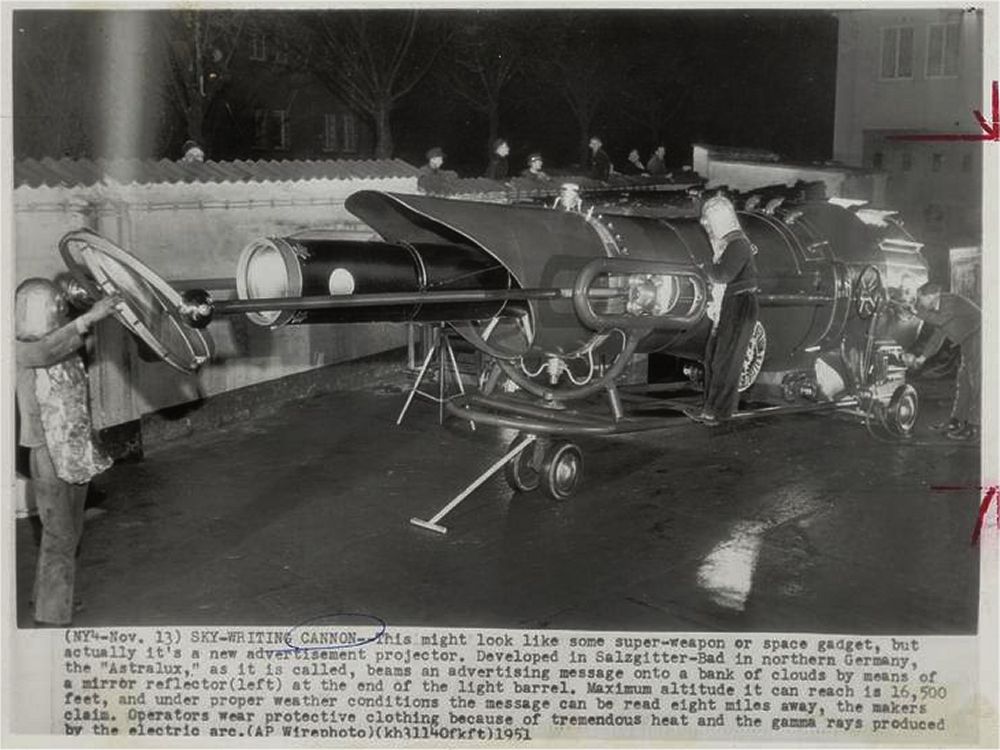
| Left: Astralux cloud image projector: Germany 1951
The machine is now identified. This is the Astralux sky-writing cannon, built in northern Germany in 1951. The caption says the cannon gave off gamma rays, but this is of course nonsense; the radiation hazard is from ultra-violet light from the arc, and wearing welder's protective goggles was very sensible. A 100V 300A generator (presumably mobile) powered an arc lamp giving 4,500,000 candlepower.
At left is the tilted mirror that directs the light upwards, mounted on two extending rods. which saves having to tilt the whole cannon. The Andreoli Spitlight (see below) is the only other projector on this page to use that method.
The red marks are a guide for cropping the photograph before publication.
The only info available is that in the caption; apart from this photograph the Astralux is unknown to Google.
|
|

| Left: Needle-beam projector: 1935
This projector has some intriguing points of similarity with the mystery item:
- There is a lamp housing which is about twice the diameter of the tube to the right.
- There is a relatively long distance between the lamp housing and the end of the tube.
- There is a handwheel on the side and a rod parallel to the tube which appears to be for focusing by moving the front of the tube in and out.
Source: Popular Science for July 1935.
There is some information on large-format slide-projectors in Wikipedia.
There is an obvious cultural reference; Batman appeared in 1939 and the Bat Signal was first used in 1941.
|
|
THE ROGERS CLOUD PROJECTOR
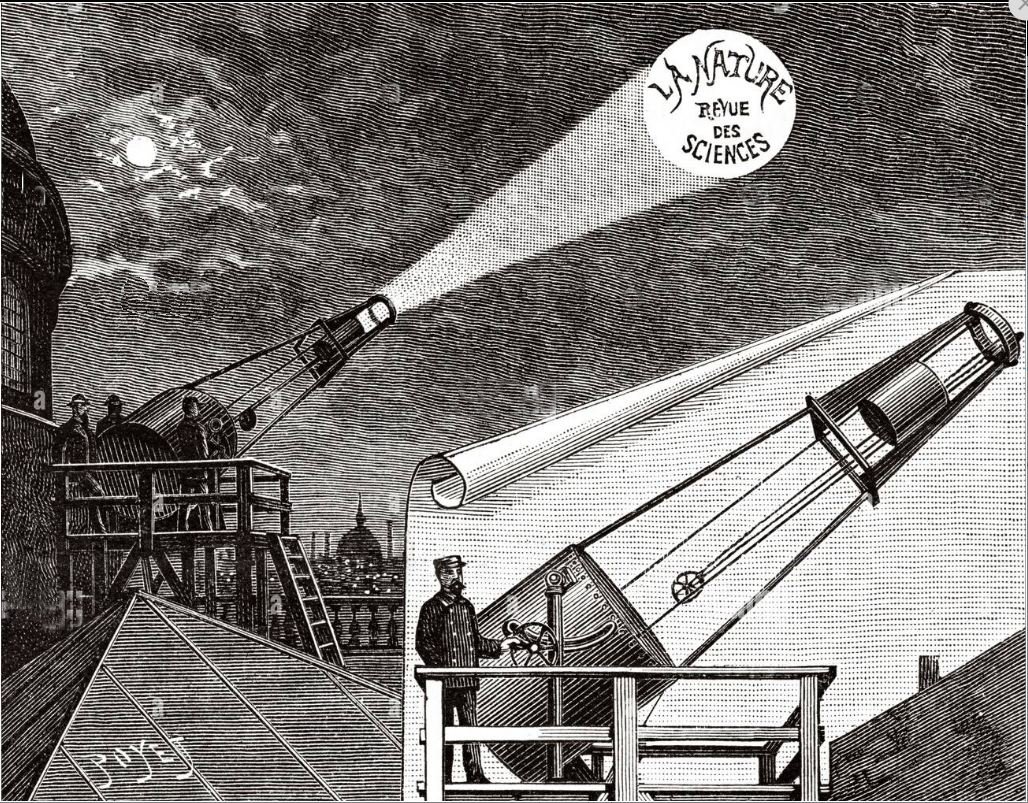
| Left: Cloud image projector: USA 1893
This looks fairly conclusive. The lens is half the diameter, or less, of the arc housing. Note the handwheel for elevation, and what appears to be a smaller handwheel for focusing the lens at the far end of the instrument.
The La Nature article now appears to have been reporting on American work by Lewis Rogers; see below
Source: La Nature 1893
|
|
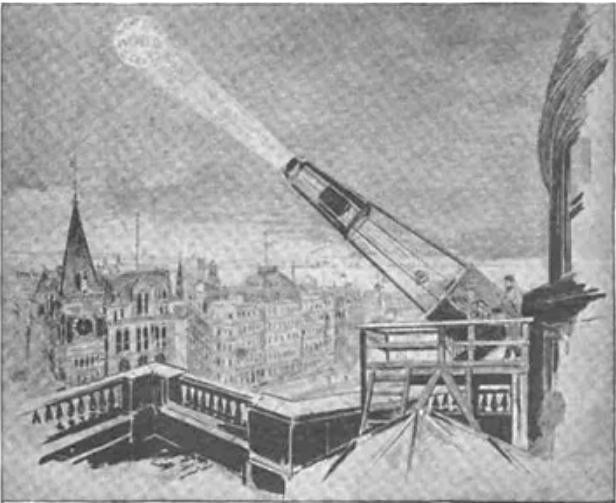
| Left: Rogers cloud image projector: USA 1893
Cloud projection experiments in the USA were carried out between 1892 and 1894 by Lewis H. Rogers, of the The Brush Company. The projector was moved to the roof of the Grand Opera in Boston (after initial experiments on Mount Washington) and Rogers experimented with projection onto clouds.
In September 1893, during the Columbia Exhibition in Chicago, the projector, was installed on the roof of the Palace of Arts and Manufactures, at a height of 200 feet. The first demonstration of the cloud projector for VIPs and the Press took place on Sunday, September 24; there was some difficulty in adjusting the new main lens.
This looks very much like the French engraving above; it probably shows the Boston Grand Opera installation. The La Nature article was reporting on these American developments.
Source: The Electrical Engineer 17 January 1894
There is more info here. (in French)
|
|

| Left: Rogers cloud image projector: USA 1893
According to histv.net, the projector consisted of a fixed focus arc lamp with a reflecting mirror two feet six inches in diameter. The reflector could be operated from below using a chain and a handwheel. (for focusing?) The design to be projected was cut out of cardboard and "placed between the two reflector lenses"; not entirely sure what that means, but it suggests there was a condenser lens in front of the arc lamp, with the other projector lens at the outer end of the device. This is a standard optical layout for slide projectors. The arc lamp was designed to use 150 amps, at 110 volts; that's a hefty 16.5 kiloWatts. The projector weighed nearly two tons.
The French engraving above was clearly taken from this photograph; note the wooden platform is the same.
Source: The Electrical Engineer 17 January 1894
|
|

AN UNKNOWN PROJECTOR
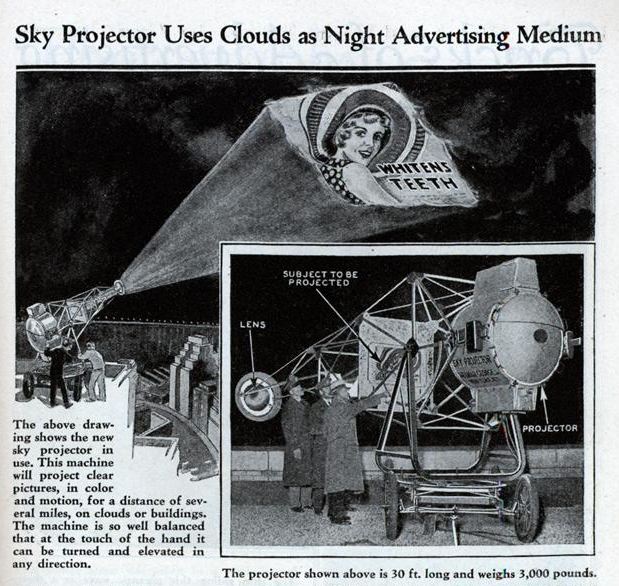
| Left: Sky image projector: USA 1931
The same format; a big-ass arc lamp housing and a much smaller lens at the far end.
Unfortunately this article gives no clue as to who built this. The top line of text on the arc housing says "EXT PROJECTOR"; googling that won't get you anywhere. The other text is not legible.
Thanks to Paul Dunlop for bringing this machine to my attention and providing the image.
|
|
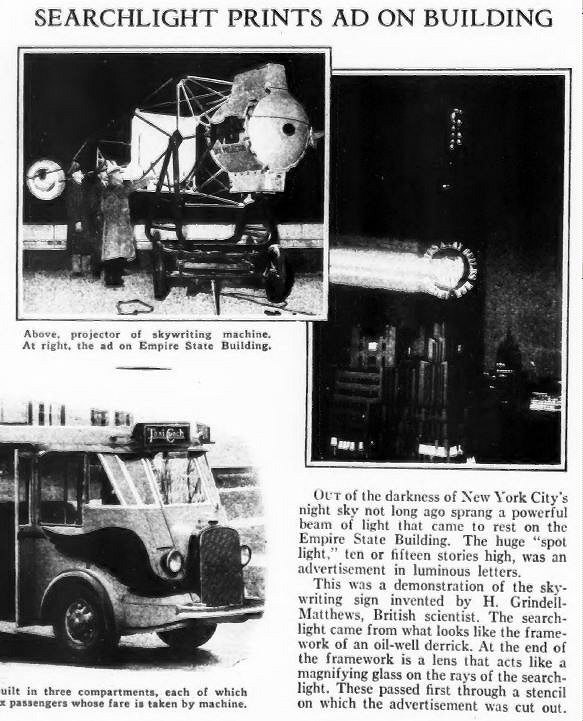
| Left: Sky image projector: USA 1931
This article however claims that Grindell-Matthews' was behind this machine. This is possible as he was in the USA from 1924 to 1930.
The photograph at left here is clearly the source of the artwork above.
Source: Popular Science for July 1931. Thanks to Pigeon for correcting the reference.
|
|

THE GERMAN PROJECTOR
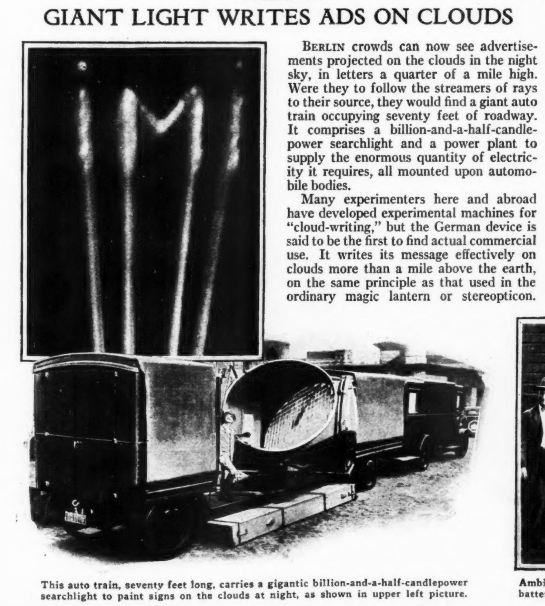
| Left: German cloud image projector: 1931
The article claims 1,500,000,000 candlepower, rather more than the 4,500,000 candlepower ascribed to the 1951 Astralux above. According to Wikipedia, a 60-inch searchlight in WW2 had a peak output of 800,000,000 candlepower, so the larger figure appears to be entirely reasonable.
The projector and generator were moved around in a road train 70 feet long.
Who actually made and used this projector is currently unknown. Anyone know?
Popular Science for June 1931. Thanks to Pigeon finding this projector.
|
|

THE GRINDELL-MATTHEWS PROJECTOR
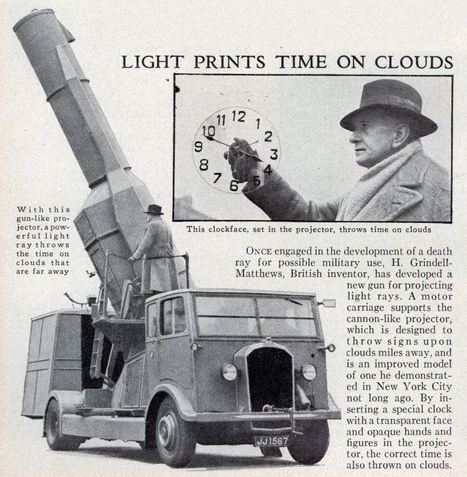
| Left: Grindell-Matthews cloud image projector: 1933
This projector was introduced by H Grindell-Matthews, in a rather desperate attempt to make some money. He projected onto clouds "Happy Christmas" and a working clock face. It was not a commercial success, and Grindell-Matthews went bankrupt the following year.
Once more the same format; a big arc lamp housing and a much smaller lens at the far end. However, this time the tube is off-centre with respect to the arc lamp housing, probably to make construction easier. This would have meant having the mirror behind the arc tilted or otherwise offset.
The duct running up the side of the tube is of unknown function; it might have housed a focusing mechanism to move the lens, or it might have ducted cooling air to said lens- there seems to be some sort of outlet near the end of the tube.
The light projector was only a small part of Grindell-Matthews' activities. He is best known for having claimed to have invented a death-ray in 1923, which he had not.
Source: Popular Science Apr 1933
Thanks to Paul Dunlop for bringing this to my attention and providing the image.
|
|
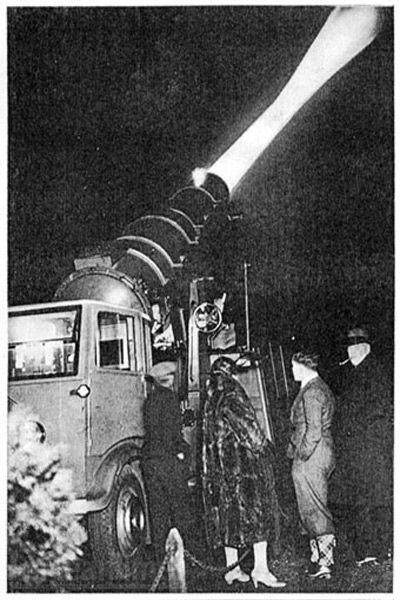
| Left: Grindell-Matthews cloud image projector: 1933
The Grindell-Matthews projector in action, probably on Hampstead Heath, London.
Source: Popular Science Apr 1933
|
|
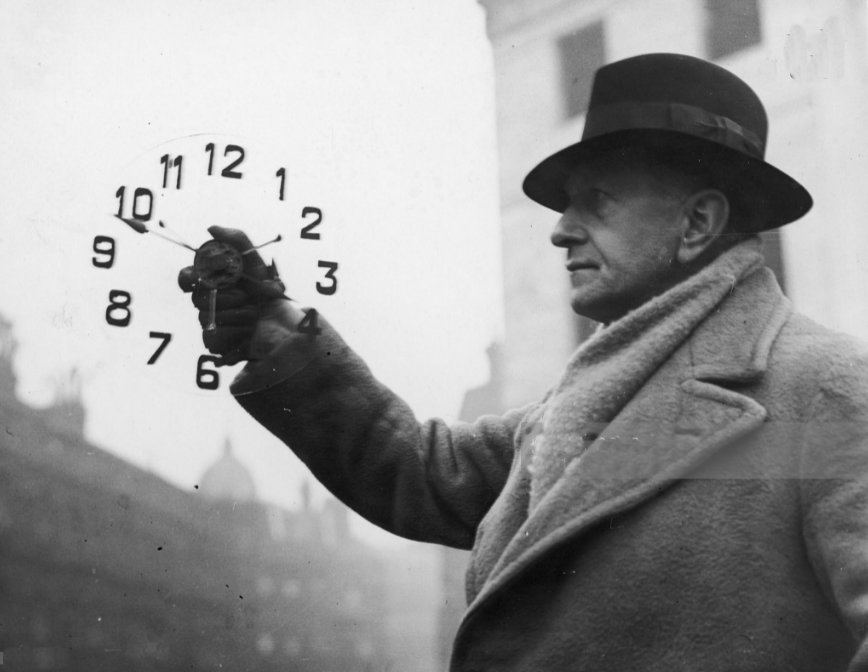
| Left: Grindell-Matthews and clock: 1933
For once we know the exact date of a photograph; 26th January 1933. Mr Grindell-Matthews holds up a clock face, intended for projection onto clouds using his rather-less-than-original invention- a cloud projector he claimed capable of beaming advertisements fifteen miles into the sky. Regrettably, clouds are rarely more than seven miles high. The projector was claimed to have a 15 million candle-power lamp and be capable of enlarging the clock until its hands were a mile long.
Grindell-Matthews appears to be holding the clock by a small round thing which was presumably some sort of motor to make the hands move.
A smaller version of this image appears in the Popular Science article above.
Source: Popular Science Apr 1933
|
|
THE ANDREOLI SPITLIGHT
The Spitlight was created in 1955 by Gianni Andreoli of Ticino. The German version of Spitlight, Lichtspucker, literally means 'light-spitter'. Not perhaps the most euphonious of names. The Spitlight was demonstrated in Switzerland, Holland and Monaco, but it made its most impact at the 1956 Winter Olympics in Cortina di Ampezzo.
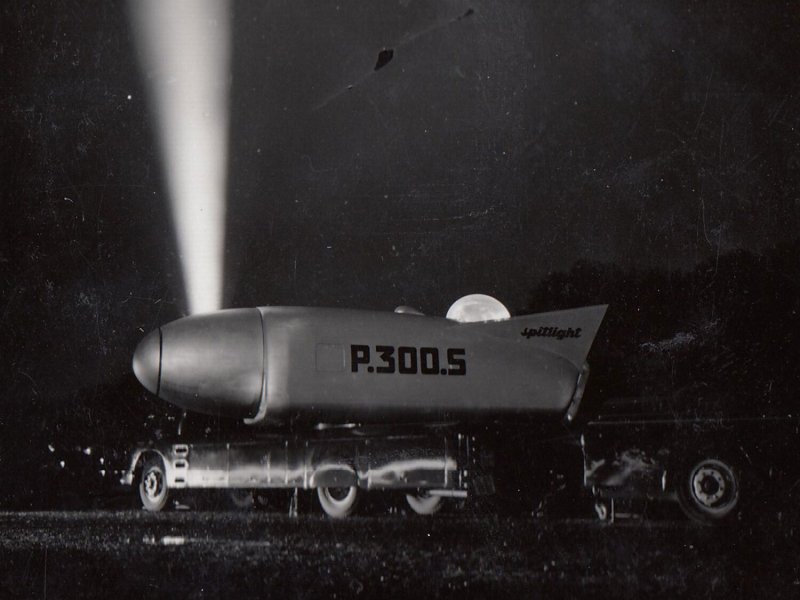
| Left: The Andreoli Spitlight image projector: Switzerland 1955
You didn't point the whole Spitlight, like earlier projectors; there was a swivelling mirror in the front section, as demonstrated by this photograph. The light output was stated as 375,000 lumens. It could project an image 833 x 833 metres across at 6km onto clouds or mountainsides. Nowadays you can buy a hand-held torch that claims to put out 100,000 lumens, more than a quarter of the Spitlight output. Forget about laser pointers, don't look into this thing.
For further comparison, by a long way the brightest (non-laser) beam of light on earth is the Sky Beam at the top of the Luxor Hotel in Las Vegas. It is rated at 42.3 billion candelas, equivalent to 130,000 100-Watt incandescent light bulbs. The beam comes from 39 xenon lamps that are each rated at 7 kW.
A word on units; the lumen measures the total luminous flux in a light beam. The candela allows for the width of the beam, so 1 candela equals 1 lumen per steradian. When a 1 lumen beam illuminates a surface of 1 square meter, this is an illuminance of 1 lux.
There is a Wikipedia page on the Spitlight.
There is more information here.
|
|
The instrument was based on a Super Ventarc carbon arc lamp, made by the firm Edgar Gretener AG. This ultra-bright (for its day) source was developed from 1948 onwards, primarily for the Eidophor television projector.
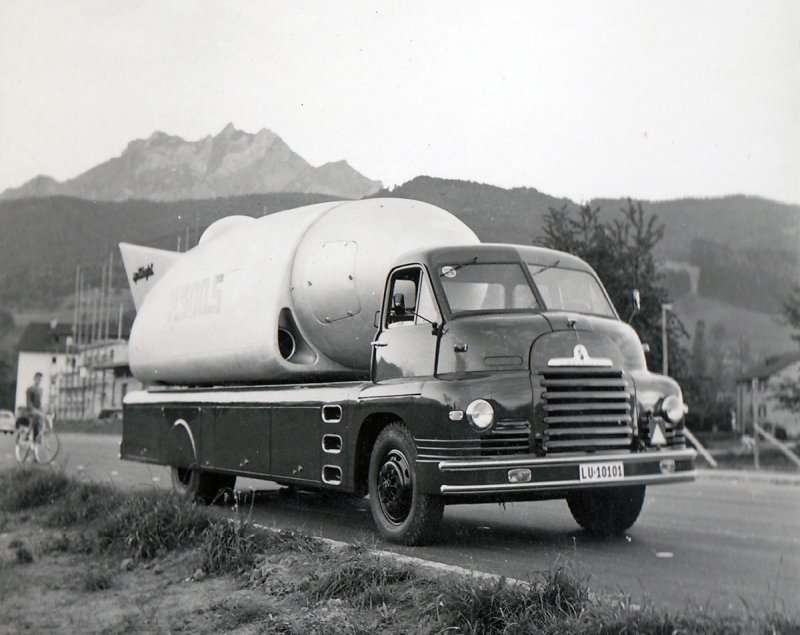
| Left: The Andreoli Spitlight image projector: Switzerland 1955
The Spitlight was mounted on a Bedford truck. It always towed a diesel generator (variously described as 120 or 170 HP) to provide the electricity.
There is more information here.
|
|

THE SKYJECTOR
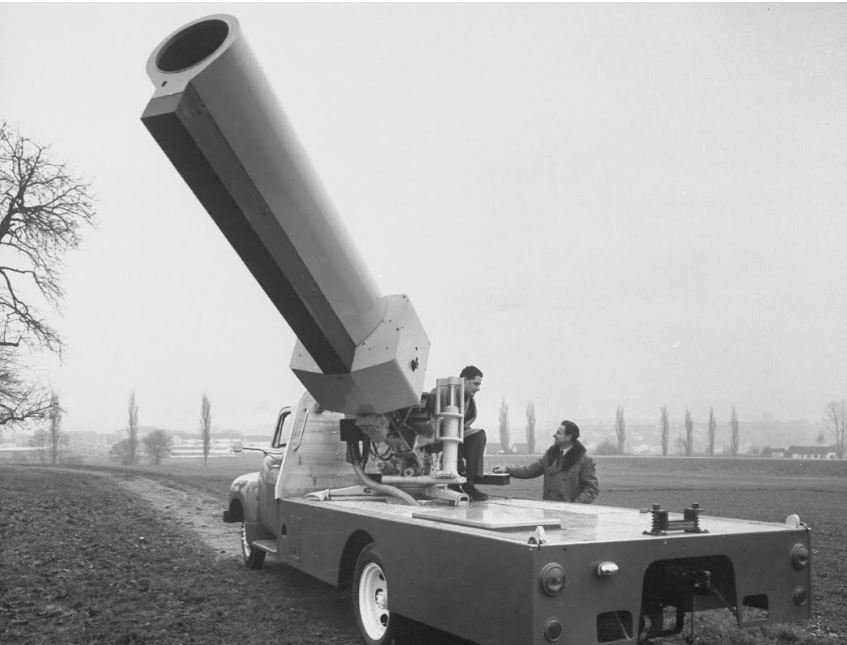
| Left: The Skyjector image projector: Switzerland 1959
This is the Skyjector; it was built in 1959 by Fernand Auberson and Michael Schwabacher; neither are known to Google. After some use in Switzerland, it was exported and used in the United States from 1960 onwards. It must have been returned for it was discovered in a junkyard near Lucerne, Switzerland, some years ago. Its present location is unknown. There is more info here.
There is a 5th March 1960 New Yorker article on the Skyjector here. It is very short on technical detail, but we learn that it was claimed to be "the most powerful (light source) ever devised by manó greater than the combined strength of seventy giant searchlights". It was powered by a towed diesel generator.
Why was Switzerland a centre of projector production? Presumably because there are lots of mountains around to project images onto.
Picture taken December 1959, somewhere in Switzerland. The two men are probably Fernand Auberson and Michael Schwabacher,
|
|
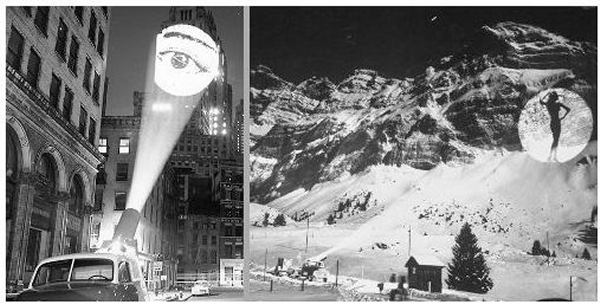
| Left: The Skyjector image projector: Switzerland 1959
These images from the 5th March 1960 New Yorker article show the Skyjector in action, in the USA and Switzerland.
|
|

In some ways the Casaba-Howitzer might be considered the ultimate projector. It was supposed to be powered by an atom bomb.























